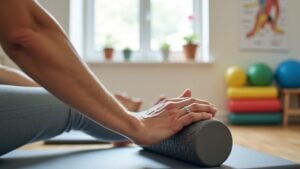Ulnar nerve entrapment can be a frustrating condition, often causing discomfort and limiting hand function. This issue arises as the ulnar nerve, which runs along the inside of the elbow, becomes compressed. People might experience tingling, numbness, or weakness in the hand and fingers. Thankfully, targeted physical therapy offers a way to alleviate these symptoms. A set of specific exercises, including wrist flexion and ulnar nerve glides, can improve mobility and strengthen the surrounding muscles. Comprehending these exercises can lead to effective relief and enhanced daily function. So, what exactly are these exercises, and how can they assist?
Understanding Ulnar Nerve Entrapment
Ulnar nerve entrapment is a condition that many people may not fully comprehend, yet it can greatly impact daily life. This occurs as the ulnar nerve gets compressed in the cubital tunnel at the elbow, a tight space measuring only about 4 millimeters.
Symptoms often include pain, numbness, or weakness specifically in the ring and pinky fingers. Common causes for this nerve entrapment include leaning on the elbows, sleeping with arms bent, and repetitive arm movements.
It’s an issue faced by many, especially those with certain jobs or activities. Significantly, cubital tunnel syndrome ranks as the second most common peripheral nerve entrapment after carpal tunnel syndrome, highlighting its importance in grasping nerve-related health concerns.
Benefits of Targeting Ulnar Nerve Pain With Exercises
While managing ulnar nerve pain can feel frustrating, engaging in targeted exercises offers a guiding light of hope for those affected.
These exercises help strengthen the muscles surrounding the ulnar nerve, reducing strain during daily tasks. Including movements like wrist flexion and elbow flexion boosts mobility, allowing the ulnar nerve to glide smoothly during activity, which decreases pressure and discomfort.
Regularly practicing these exercises not only promotes short-term relief but also supports long-term nerve health, preventing future issues. Additionally, monitoring pain levels during these exercises guarantees adjustments can be made, optimizing recovery results.
Through committing to a consistent exercise routine, individuals can reclaim functionality and improve their complete quality of life.
The Importance of Proper Technique in Exercise
Engaging in exercises for ulnar nerve entrapment can be a game changer, but solely in the event that they are performed with the right technique. Proper technique is essential for ensuring the effectiveness of hand and wrist exercises while minimizing the risk of injury. Maintaining correct posture, such as keeping the wrist straight, improves the benefits of each movement.
| Key Element | Proper Technique Benefits | Monitoring Techniques |
|---|---|---|
| Posture | Reduces strain on nerves | Use mirrors for feedback |
| Alignment | Increases exercise effectiveness | Seek guidance from a therapist |
| Body Awareness | Prevents pain and discomfort | Listen to your body signals |
Exercise 1: Wrist Flexion and Extension
Hand and wrist exercises play a significant role in boosting the health of the ulnar nerve. One effective exercise is wrist flexion and extension, which strengthens and stretches wrist muscles, reducing strain on the nerve.
To perform this exercise, the individual should place their forearm on a table, with the affected hand extending beyond the edge, palm facing down. They then bend the wrist to form a fist, holding this position for about six seconds.
After flexion, the hand should be lowered as far as possible, allowing the fingers to straighten for another six seconds. It is recommended to repeat these movements eight to twelve times, including the other hand to guarantee balanced strength, ideally twice daily to improve wrist mobility.
Exercise 2: Ulnar Nerve Glides
Ulnar nerve glides are essential exercises aimed at enhancing the mobility of the ulnar nerve, which can help alleviate discomfort and reduce inflammation.
These movements, including elbow flexion and wrist extension, facilitate the nerve’s movement through the cubital tunnel, improving general nerve function.
It is advisable for individuals to incorporate these glides into their routine three to five times a week for the best results.
Benefits of Nerve Gliding
While many could overlook the importance of nerve health, including ulnar nerve glides into a daily routine can offer substantial benefits for those experiencing discomfort or restricted movement.
These exercises are designed to improve the mobility of the ulnar nerve, allowing it to glide freely through the cubital tunnel. Through integrating nerve gliding techniques, individuals can reduce inflammation and adhesions along the nerve path, which might alleviate pain associated with cubital tunnel syndrome.
Research shows that performing these exercises three to five times a week can lead to significant symptom improvements. Plus, since ulnar nerve glides require no special equipment, they are an accessible option for anyone seeking relief through Physical Therapy.
Exercise Technique Overview
Performing ulnar nerve glides can greatly improve the mobility of the ulnar nerve, offering relief to those managing discomfort. This exercise involves gently flexing the elbow while extending the wrist, which helps stretch the ulnar nerve effectively. Holding this position for 15-30 seconds and repeating it three times on each arm can markedly reduce pain.
| Step | Description |
|---|---|
| 1. Position | Sit or stand comfortably with the head up. |
| 2. Flex Elbow | Gently flex the elbow while extending the wrist. |
| 3. Hold | Maintain the position for 15-30 seconds. |
| 4. Repeat | Perform three repetitions for each arm. |
Practicing proper technique is crucial to avoid worsening symptoms, and consulting a healthcare professional before starting these exercises is highly recommended.
Frequency and Duration Recommendations
For those looking to improve their ulnar nerve mobility, engaging in gliding exercises consistently can make a world of difference.
The frequency and duration recommendations for these exercises are essential for effective results. It is advisable to perform ulnar nerve glides once a day, three to five times per week, or as tolerated. Each glide should be held for 15-30 seconds, allowing the nerve to stretch and mobilize properly while returning to the starting position.
- Monitor pain levels during and after each session.
- Perform the exercises in a controlled manner to avoid discomfort.
- Consistency is key; regular practice can lead to significant advancements in symptoms.
With careful attention to these guidelines, individuals can improve their ulnar nerve health.
Exercise 3: Grip Strengthening Exercises
Grip strengthening exercises serve as an essential tool in alleviating discomfort associated with ulnar nerve entrapment.
These exercises typically involve using a stress ball or therapeutic putty to build strength in the hand and forearm muscles of the affected arm. Through improving grip strength, individuals can reduce strain on the ulnar nerve and better hand function.
Performing 10-15 repetitions once daily is recommended for ideal results. Consistency is key; regular practice not only promotes better grip but also aids in preventing future discomfort.
As these muscles grow stronger, daily tasks become easier and less painful, leading to long-term nerve health. Including grip strengthening exercises into a routine can greatly improve quality of life.
Exercise 4: Forearm Pronation and Supination
Improving forearm strength and flexibility plays an important role in managing symptoms of ulnar nerve entrapment. A useful exercise involves forearm pronation and supination.
To perform this, place your forearm on a table, gently bend your wrist, and rotate your hand to turn your palm up, followed by turning it palm down. This exercise should be done in sets of 10 repetitions for each arm, twice daily.
- Improves flexibility in the forearm muscles.
- Promotes better blood flow to the ulnar nerve.
- Reduces strain during daily activities.
Ensuring that the elbow stays close to the body while rotating helps avoid unnecessary strain.
Consistent practice can greatly improve wrist and hand mobility, aiding in symptom relief.
Conclusion
In the grand theater of life, our hands often take center stage, yet the ulnar nerve can play the unwelcome role of a pesky understudy, stealing joy from simple tasks. But fear not—through consistent physical therapy and targeted exercises, one can reclaim their starring role. As we welcome these movements, we change discomfort into strength, turning our hands into the unsung heroes of daily life once more. The path might be challenging, but the rewards are simply priceless.





